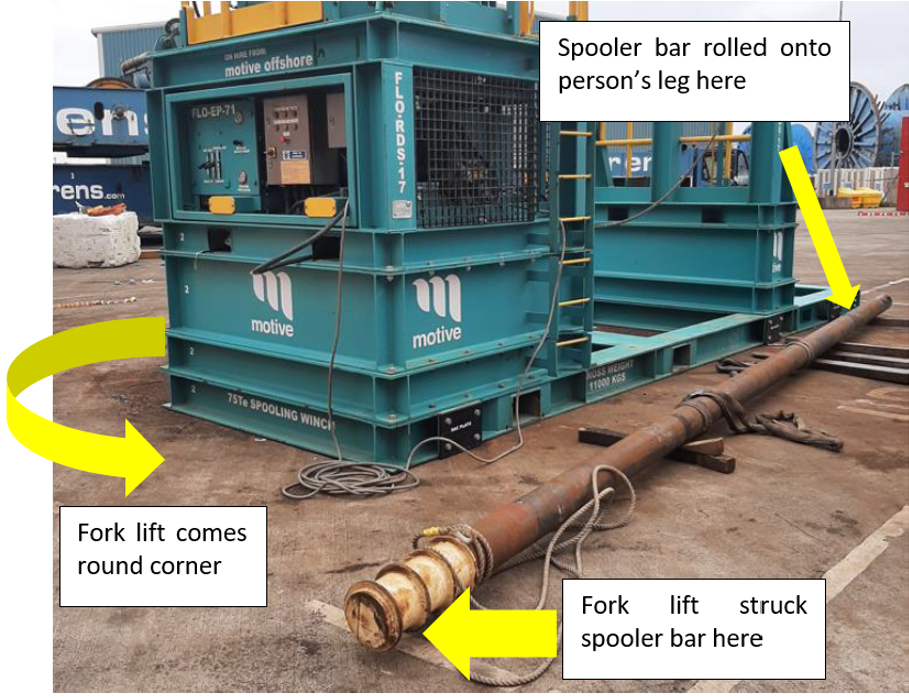LTI – forklift knocked spooler bar onto person’s leg
What happened
While helping with spooling operations at a third-party yard, a person was injured in the lower leg, when a forklift truck struck the edge of a spooler bar causing it to roll onto his legs, resulting in soft tissue damage. The injured person was working on a spooling winch, with the spooler bar positioned behind him, resting on wooden chocks. The forklift truck reversed from the rear of the spooling winch and struck the edge of the spooler bar, resulting in it rolling from the wooden chocks onto the persons’ leg. He was unable to work for four days.
- What was expected to happen?
- It was planned that spooler bar would be inserted into the reel;
- What actually happened?
- The wrong size of spooler bar was provided by a sub-contractor, and this led to the spooler bar being placed in an unsafe position in the working area of the person who was injured;
What went wrong?
- There were only two personnel involved in conducting the operation, and the supervisor was also fulfilling the role of forklift truck operator and rigger;
- There were no hard barriers in place to mitigate hazard of impact/collision;
- The impact sensors on the forklift truck did not detect the spooler bar when reversing, as the sensor was positioned at the top of the forklift truck and the spooler bar was below this level;
- The forklift truck operator unexpectedly decided to reverse the forklift truck through a congested working area with no banksman.
What went right, what prevented this from being worse than it was?
- The injured person received first aid treatment on site and was quickly transferred to local hospital for X-ray and further assessment.

Actions taken
- Verified that existing risk assessments for fork-lift truck operations were fully aligned with company requirements and specifically cover:
- Access, moving the fork-lift truck, the travelling surface and obstructions at the work location;
- Signalling and communications protocol.
- If the fork-lift truck operator’s vision is obscured, always use a Banksman to guide the fork-lift truck;
- Reviewed use of sensors and alarms on fork-lift trucks to mitigate impact/collision risk;
- Subsequently, the subcontractor involved installed reversing cameras on all forklifts.
Members may wish to refer to:
Safety Event
Published: 22 January 2024
Download: IMCA SF 02/24
IMCA Safety Flashes
Submit a Report
IMCA Safety Flashes summarise key safety matters and incidents, allowing lessons to be more easily learnt for the benefit of all. The effectiveness of the IMCA Safety Flash system depends on Members sharing information and so avoiding repeat incidents. Please consider adding [email protected] to your internal distribution list for safety alerts or manually submitting information on incidents you consider may be relevant. All information is anonymised or sanitised, as appropriate.
IMCA’s store terms and conditions (https://www.imca-int.com/legal-notices/terms/) apply to all downloads from IMCA’s website, including this document.
IMCA makes every effort to ensure the accuracy and reliability of the data contained in the documents it publishes, but IMCA shall not be liable for any guidance and/or recommendation and/or statement herein contained. The information contained in this document does not fulfil or replace any individual’s or Member's legal, regulatory or other duties or obligations in respect of their operations. Individuals and Members remain solely responsible for the safe, lawful and proper conduct of their operations.
